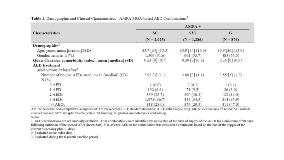Real-World Use and Clinical Characteristics of Patients Treated with Antiepileptic Drug Combinations With and Without Perampanel in the United States
Abstract number :
2.259
Submission category :
7. Antiepileptic Drugs / 7C. Cohort Studies
Year :
2018
Submission ID :
500069
Source :
www.aesnet.org
Presentation date :
12/2/2018 4:04:48 PM
Published date :
Nov 5, 2018, 18:00 PM
Authors :
François Laliberté, Groupe d’analyse, Ltée; Jiyoon Choi, Eisai Inc; Mei Sheng Duh, Analysis Group, Inc.; Manoj Malhotra, Eisai Inc.; Victoria Barghout, VEB HealthCare LLC; Guillaume Germain, Groupe d’analyse, Ltée; Cristi O
Rationale: Combining antiepileptic drugs (AEDs) with a different mechanism of action (MOA) is common practice, especially among patients with refractory epilepsy, but information on adjunctive therapy strategies is limited. Following the introduction of AEDs with novel MOA such as perampanel (AMPA), this study aims to evaluate clinical characteristics and AEDs use among patients treated with selected AED combinations with and without AMPA in a real-world setting. Methods: A retrospective study was conducted using a large nationally representative claims database from Symphony Health Solutions’ Integrated Dataverse (IDV®; 08/2012–07/2017). The study included patients =12 years treated with AED combinations (identified as an overlap in days of supply of =2 AEDs for at least 90 consecutive days [termed as the index date]), =180 days of continuous clinical activity prior to (baseline) and post (follow-up) index date, and with =1 diagnosis of epilepsy or non-febrile convulsions at baseline. AEDs were categorized into the following MOA categories: selective non-competitive antagonist of AMPA receptors (AMPA), sodium channel blockers (SC), synaptic vesicle protein 2A binding (SV2), and gamma-aminobutyric acid analogs (G). Patients treated with selected AED combinations including AMPA were classified into the following MOA-based cohorts: AMPA+SC, AMPA+SV2, and AMPA+G. Similarly, non-AMPA users with eligible AED combinations were classified as follows: SC+SC, SC+SV2, SC+G, and SV2+G. Of note, AED combination cohorts are not mutually exclusive. Baseline demographics and clinical characteristics as well as AED use were described for each MOA-based combination cohort. Results: A total of 3,221 and 171,861 unique patients used selected AMPA and non-AMPA AED combinations, respectively. Among AMPA users, 2,923 AMPA+SC, 1,286 AMPA+SV2, and 874 AMPA+G AED combinations were identified (Table 1). Among non-AMPA patients, 12,840 SC+SC, 45,965 SC+SV2, 67,140 SC+G, and 54,575 SV2+G AED combinations were identified (Table 2). The mean age of the AMPA combination cohorts varied between 36–37 years and 52%–56% of patients were female, while patients in the non-AMPA combination cohorts were qualitatively older (44–53 years) with 52%–63% of female patients. The mean Quan-Charlson comorbidity index scores ranged from 0.24 (AMPA+SC) to 0.38 (AMPA+G) for AMPA combination cohorts and from 0.35 (SC+SC) to 0.86 (SV2+G) for the non-AMPA combination cohorts. More than 60% of patients in each AMPA combination cohorts used =3 unique AEDs at baseline, while this proportion was between 10% and 21% among the non-AMPA combination cohorts. Conclusions: This study provides insight into the current use of AED combinations for the treatment of epilepsy, including how different MOA are used in combination with AMPA. AMPA combinations are used later in the sequence of treatment and among a younger population. This information could help treatment decision making regarding use of AED combinations. Funding: Financial support provided by Eisai Inc.

.tmb-.jpg?Culture=en&sfvrsn=9229e486_0)